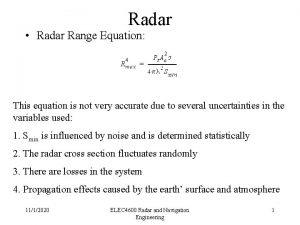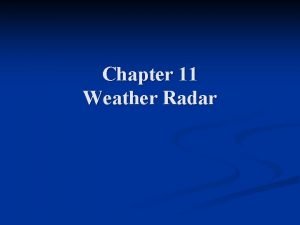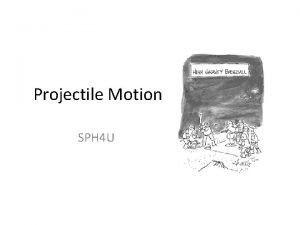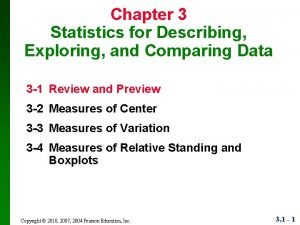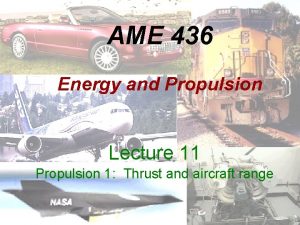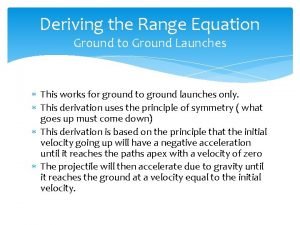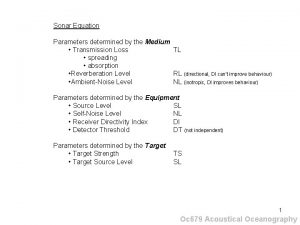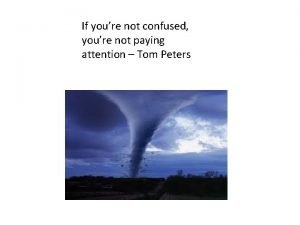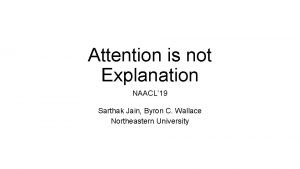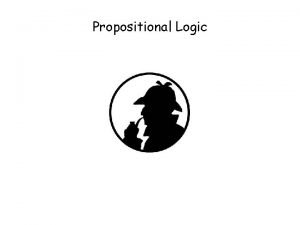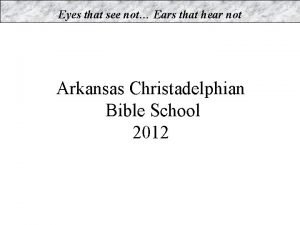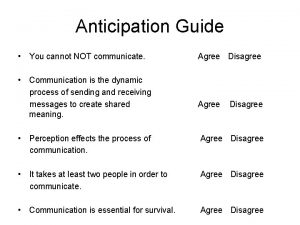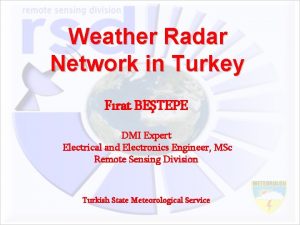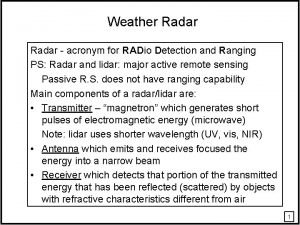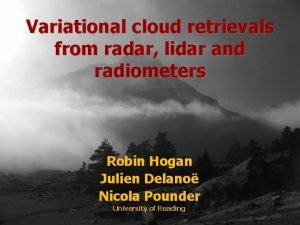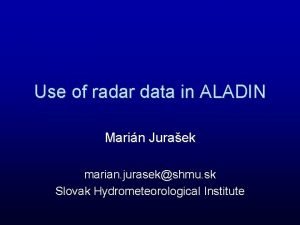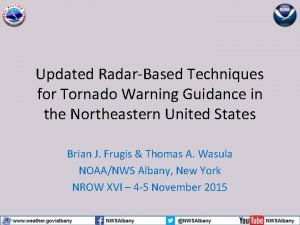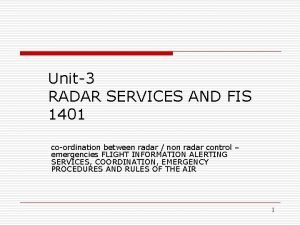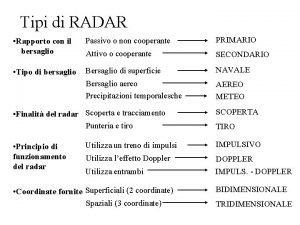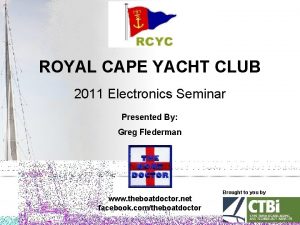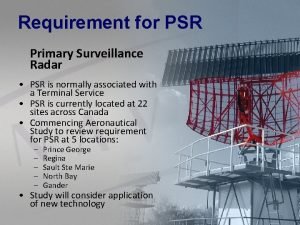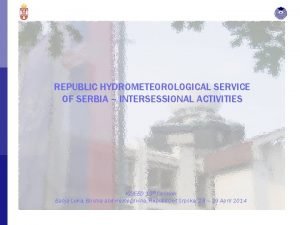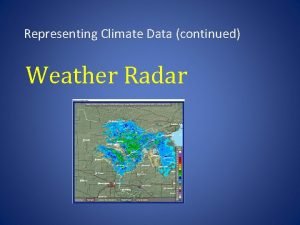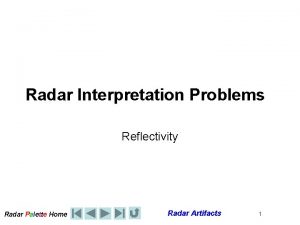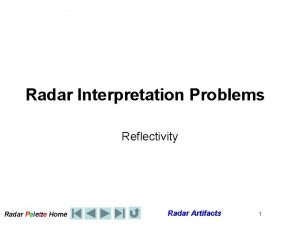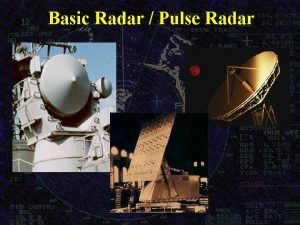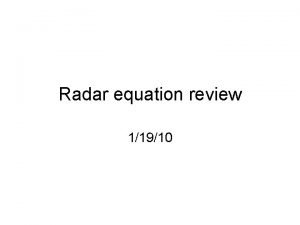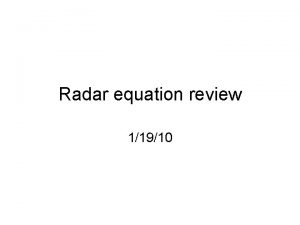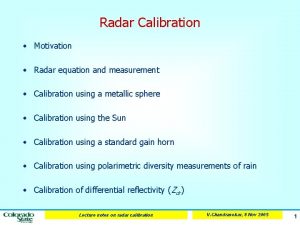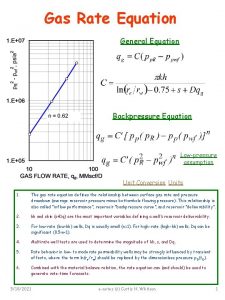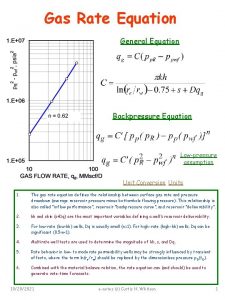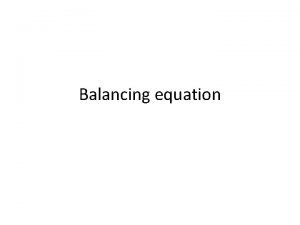Radar Radar Range Equation This equation is not



































![Integration of Radar Pulses False Alarm Number nf = [T/ τ][f. P][Tfa] But T Integration of Radar Pulses False Alarm Number nf = [T/ τ][f. P][Tfa] But T](https://slidetodoc.com/presentation_image/3c34afc4b75991556f8d35fa5acfb24d/image-36.jpg)




- Slides: 40

Radar • Radar Range Equation: This equation is not very accurate due to several uncertainties in the variables used: 1. Smin is influenced by noise and is determined statistically 2. The radar cross section fluctuates randomly 3. There are losses in the system 4. Propagation effects caused by the earth’ surface and atmosphere 11/1/2020 ELEC 4600 Radar and Navigation Engineering 1

Radar • Probabilities – Due to the statistical nature of the variables in the radar equation we define performance based on two main factors • Probability of Detection (Pd) – The probability that a target will be detected when one is present • Probability of False Alarm (Pfa) – The probability that a target will be detected when one is not present 11/1/2020 ELEC 4600 Radar and Navigation Engineering 2

Minimum Signal • Detection of Signals in Noise Typical output from receiver’s video amplifier, We have to determine how to decide whether a signal is present or not 11/1/2020 ELEC 4600 Radar and Navigation Engineering 3

Minimum Signal • Threshold Detection Set a threshold level and decide that any signal above it is a valid reply from a target. Two problems: 1. If the threshold is set too high Probability of Detection is low 2. If the threshold is set too low Probability of False Alarm is high 11/1/2020 ELEC 4600 Radar and Navigation Engineering 4

Receiver Noise and Signal/Noise Ratio • Source of Noise is primarily thermal or Johnson Noise in the receiver itself • Thermal noise Power = k. TBn – Where k is Boltzmann’s Constant (1. 38 x 10 -23 J/K) – T is the temperature in Kelvins (~Celsius +273) – B is the Noise Bandwidth of the receiver 11/1/2020 ELEC 4600 Radar and Navigation Engineering 5

Receiver Noise and Signal/Noise Ratio • Noise Bandwidth H(f 0) Bn 11/1/2020 ELEC 4600 Radar and Navigation Engineering 6

Receiver Noise and Signal/Noise Ratio • Noise Bandwidth H(f 0) Bn In practice, the 3 d. B bandwidth is used. 11/1/2020 ELEC 4600 Radar and Navigation Engineering 7

Receiver Noise and Signal/Noise Ratio • Noise Figure – Amplifiers and other circuits always add some noise to a signal and so the Signal to Noise Ratio is higher at the output than at the input – This is expressed as the Noise Figure of the Amplifier (or Receiver) – Fn= (noise out of a practical reciver) (noise out of an ideal (noiseless) receiver at T 0) Ga is the receiver gain 11/1/2020 ELEC 4600 Radar and Navigation Engineering 8

Receiver Noise and Signal/Noise Ratio • Since Ga = So / Si (Output/Input) and k. T 0 B is the input noise Ni then finally 11/1/2020 ELEC 4600 Radar and Navigation Engineering 9

Receiver Noise and Signal/Noise Ratio • Since Ga = So / Si (Output/Input) and k. T 0 B is the input noise Ni then finally 11/1/2020 ELEC 4600 Radar and Navigation Engineering 10

Receiver Noise and Signal/Noise Ratio • Modified Range Equation 11/1/2020 ELEC 4600 Radar and Navigation Engineering 11

Probability Density Functions Noise is a random phenomenon e. g. a noise voltage can take on any value at any time Probability is a measure of the likelihood of discrete event Continuous random functions such as noise voltage are described by probability density functions (pdf) 11/1/2020 ELEC 4600 Radar and Navigation Engineering 12

Probability Density Functions e. g. 11/1/2020 ELEC 4600 Radar and Navigation Engineering 13

Probability Density Functions e. g. for a continuous function 11/1/2020 ELEC 4600 Radar and Navigation Engineering 14

Probability Density Functions • Definitions – Mean Square – Variance 11/1/2020 ELEC 4600 Radar and Navigation Engineering 15

Common PDFs • Uniform This is the pdf for random phase 11/1/2020 ELEC 4600 Radar and Navigation Engineering 16

Common PDFs • Gaussian or Normal Very common distribution Uniquely defined by just the first and second moments Central Limit Theorem 11/1/2020 ELEC 4600 Radar and Navigation Engineering 17

Common PDFs • Rayleigh Variance Detected envelope of filter output if input is Gaussian Uniquely defined by either the first or second moment 11/1/2020 ELEC 4600 Radar and Navigation Engineering 18

Common PDFs • Exponential Note: Probable Error in Notes 11/1/2020 ELEC 4600 Radar and Navigation Engineering 19

Calculation of Minimum Signal to Noise Ratio • First we will determine threshold level required to give the specified average time to false alarm (Tfa). This is done assuming no signal input. We shall also get a relationship between Tfa and Pfa. • Then we add the signal and determine what signal to noise ratio we need to give us the specified probability of detection (Pd) 11/1/2020 ELEC 4600 Radar and Navigation Engineering 20

Calculation of Minimum Signal to Noise Ratio Gauss in BV BIF/2 Rayleigh out Pfa= 11/1/2020 ELEC 4600 Radar and Navigation Engineering 21

Calculation of Minimum Signal to Noise Ratio assuming tk=1/BIF 11/1/2020 ELEC 4600 Radar and Navigation Engineering 22

Calculation of Minimum Signal to Noise Ratio Now we have a relationship between False alarm time and the threshold to noise ratio This can be used to set the Threshold level 11/1/2020 ELEC 4600 Radar and Navigation Engineering 23

Calculation of Minimum Signal to Noise Ratio Now we add a signal of amplitude A and the pdf becomes Ricean. i. e. a Rice distribution This is actually a Rayleigh distribution distorted by the presence of a sine wave Where I 0 is a modified Bessel function of zero order 11/1/2020 ELEC 4600 Radar and Navigation Engineering 24

Calculation of Minimum Signal to Noise Ratio This is plotted in the following graph 11/1/2020 ELEC 4600 Radar and Navigation Engineering 25

Calculation of Minimum Signal to Noise Ratio From this graph, the minimum signal to noise ratio can be derived from: a. the probability of detection b. the probability of false alarm 11/1/2020 ELEC 4600 Radar and Navigation Engineering 26

Integration of Radar Pulses Note that the previous calculation for signal to noise ratio is based on the detection of a single pulse In practice a target produces several pulses each time the antenna beam sweeps through its position Thus it is possible to enhance the signal to noise ratio by integrating (summing ) the pulse outputs. Note that integration is equivalent to low pass filtering. The more samples integrated, the narrower the bandwidth and the lower the noise power 11/1/2020 ELEC 4600 Radar and Navigation Engineering 27

Integration of Radar Pulses Note: The antenna beam width nb is arbitrarily defined as the angle between the points at which the pattern is 3 d. B less than the maximum Beam Width θB If the antenna is rotating at a speed of θS º/s 3 d. B and the Pulse repetition frequency is fp the number of pulses on target is n. B = θB fp / θS or if rotation rate is given in rpm (ωm) n. B = θB fp / 6 ωm 11/1/2020 ELEC 4600 Radar and Navigation Engineering 28

Integration of Radar Pulses Integration before detection is called predetection or coherent detection Integration after detection is called post detection or noncoherent detection If predetection is used SNRintegrated = n SNR 1 If postdetection is used, SNRintegrated n SNR 1 due to losses in the detector 11/1/2020 ELEC 4600 Radar and Navigation Engineering 29

Integration of Radar Pulses Predetection integration is difficult because it requires maintaining the phase of the pulse returns Postdetection is relatively easy especially using digital processing techniques by which digitized versions of all returns can be recorded and manipulated 11/1/2020 ELEC 4600 Radar and Navigation Engineering 30

Integration of Radar Pulses The reduction in required Signal to Noise Ratio achieved by integration can be expressed in several ways: Integration Efficiency: Note that Ei(n) is less than 1 (except for predetection) Where (S/N)1 is the signal to noise ratio required to produce the required Pd for one pulse and And (S/N)n is the signal to noise ratio required to produce the required Pd for n pulses 11/1/2020 ELEC 4600 Radar and Navigation Engineering 31

Integration of Radar Pulses The improvement in SNR where n pulses are integrated is called the integration improvement factor Ii(n) Note that Ii(n) is less than n Another expression is the equivalent number of pulses neq 11/1/2020 ELEC 4600 Radar and Navigation Engineering 32

Integration of Radar Pulses Integration Improvement Factor 11/1/2020 ELEC 4600 Radar and Navigation Engineering 33

Integration of Radar Pulses False Alarm Number Note the parameter nf in the graph This is called the false alarm number and is the average number of “decisions” between false alarms Decisions are considered as the discrete points at which a target may be detected unambiguously Recall that the resolution of a radar is half the pulse width multiplied by the speed of light τ τ τ 11/1/2020 ELEC 4600 Radar and Navigation Engineering 34

Integration of Radar Pulses False Alarm Number Thus the total number of unambiguous targets for each transmitted pulse is T/ τ where T is the pulse repetition period (1/f. P) We multiply this by the number of pulses per second (f. P) to get the number of decisions per second Finally we multiply by the False alarm rate (Tfa) to get the number of decisions per false alarm. nf = [T/ τ][f. P][Tfa] 11/1/2020 ELEC 4600 Radar and Navigation Engineering 35
![Integration of Radar Pulses False Alarm Number nf T τf PTfa But T Integration of Radar Pulses False Alarm Number nf = [T/ τ][f. P][Tfa] But T](https://slidetodoc.com/presentation_image/3c34afc4b75991556f8d35fa5acfb24d/image-36.jpg)
Integration of Radar Pulses False Alarm Number nf = [T/ τ][f. P][Tfa] But T x f. P =1 and τ 1/B where B is the IF bandwidth so nf Tfa B 1/Pfa 11/1/2020 ELEC 4600 Radar and Navigation Engineering 36

Integration of Radar Pulses Effect on Radar Range Equation with integration Expressed in terms of SNR for 1 pulse 11/1/2020 ELEC 4600 Radar and Navigation Engineering 37

Integration of Radar Pulses Example: Radar: PRF: 500 Hz Bandwidth : 1 MHz Antenna Beamwidth: 1. 5 degrees Gain: 24 d. B Transmitter Power 2 MW Noise Figure: 2 d. B Pd: 80% PFA: 10 -5 σ: 2 m 2 Freq: 1 GHz Antenna Rotation speed: 30 degrees/s What is maximum range? 11/1/2020 ELEC 4600 Radar and Navigation Engineering 38

Radar Cross Section (RCS) To simplify things the radar range equation assumes that a target with cross sectional area σ absorbs all of the incident power and reradiates it uniformly in all directions. This, of course, is not true When the radar pulse hits a target the energy is reflected and refracted in many ways depending on a. the material it is made of b. Its shape c. Its orientation with respect to the radar 11/1/2020 ELEC 4600 Radar and Navigation Engineering 39

END 11/1/2020 ELEC 4600 Radar and Navigation Engineering 40
 This is
This is Radar systems analysis and design using matlab
Radar systems analysis and design using matlab Difference between mti and pulse doppler radar
Difference between mti and pulse doppler radar Frequency response of single delay line canceller
Frequency response of single delay line canceller Vrm radar
Vrm radar Sadlier unit 1 level d synonyms
Sadlier unit 1 level d synonyms As compared to long-range forecasts, short-range forecasts
As compared to long-range forecasts, short-range forecasts Weather radar equation
Weather radar equation Range equation projectile
Range equation projectile Breguet range equation
Breguet range equation Range rule of thumb equation
Range rule of thumb equation Breguet range equation
Breguet range equation Range equation derivation
Range equation derivation Sonar range equation
Sonar range equation If you're not confused you're not paying attention
If you're not confused you're not paying attention Casual informal style
Casual informal style Attention is not not explanation
Attention is not not explanation Not too broad and not too narrow
Not too broad and not too narrow If not p then q
If not p then q Just right scale
Just right scale Love is not all about
Love is not all about Eyes that see not ears that hear not
Eyes that see not ears that hear not Pp not not
Pp not not If you don't measure it you can't manage it
If you don't measure it you can't manage it We will not be shaken we will not be moved
We will not be shaken we will not be moved Not a rustling leaf, not a bird in flight
Not a rustling leaf, not a bird in flight You can not not communicate
You can not not communicate Radar dmi
Radar dmi Radar stands for radio detection and
Radar stands for radio detection and Radar lidar
Radar lidar Shmu radar
Shmu radar Nrot radar
Nrot radar Radar control service
Radar control service Tma radar
Tma radar Tipi di radar
Tipi di radar Agility health radar questions
Agility health radar questions Radar plotting
Radar plotting Nav canada cfps
Nav canada cfps Republic hydrometeorological institute of serbia
Republic hydrometeorological institute of serbia Radar example
Radar example Search and rescue radar transponder
Search and rescue radar transponder
